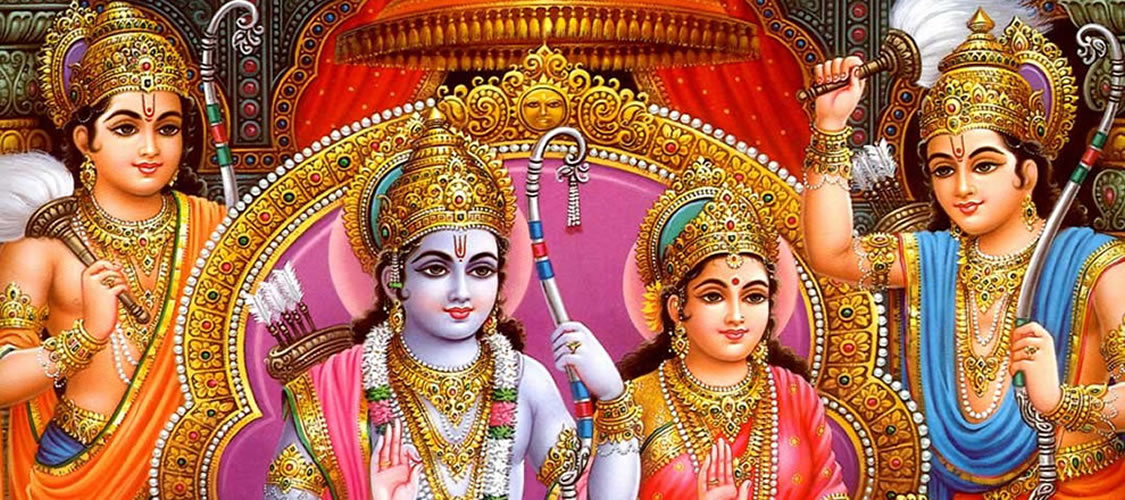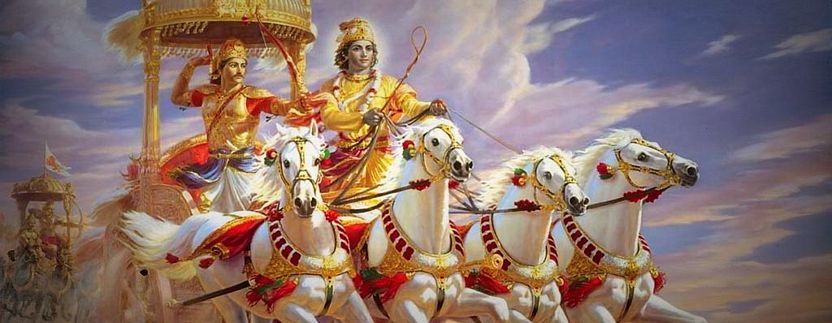Indian Epics, Ramayana, Mahabharata
The story of RAMAYANA
And just to let you know what you are in for, here is a very brief summary of the Ramayana, the adventures of lord Rama. Rama is the son of King Dasaratha, but he is also an incarnation of the god Vishnu, born in human form to do battle with the demon lord Ravana. Ravana had obtained divine protection against other demons, and even against the gods - but because he scorned the world of animals and men, he had not asked for protection from them. Therefore, Vishnu was incarnated as a human being in order to put a stop to Ravana. King Dasaratha has three other sons besides Rama.
There is Lakshmana, who is devoted to Rama. There is Bharata, the son of Dasaratha's pretty young wife Kaikeyi, and there is Satrughna, who is as devoted to Bharata as Lakshmana is to Rama. When Dasaratha grows old, he decides to name Rama as his successor. Queen Kaikeyi, however, is outraged. She manages to compel Dasaratha to name their son Bharata as his successor instead, and to send Rama into exile in the forest. Rama agrees to go into exile, and he is accompanied by his wife Sita and his brother Lakshmana. When their exile is nearly over, Sita is abducted by the evil Ravana who carries her off to Lanka city (on the island of Sri Lanka). Rama and Lakshmana follow in pursuit, and they are aided by the monkey lord, Hanuman, who is absolutely devoted to Rama. After many difficulties and dangers, Rama finally confronts Ravana and defeats him in battle. What happens after that is a matter of some dispute in the different versions of the Ramayana. Did Rama accept Sita back into his household? Or did he send her away because she had been in the possession of another male? You will see different versions of the ending of the story in the books that you will read for this class.
A Digression About Time: In historical terms, the events of the Ramayana precede the events of the Mahabharata. The time periods of Hindu mythology are called "yugas", and the world as we know it goes through a cycle of four yugas. Sometimes these four yugas are compared to a cow standing on four legs. In the "Best Age," the Krita Yuga, the cow is standing on all four legs. In the next age, the Treta Yuga, or "Age of Three," the cow is standing on only three legs and is slightly teetering: the world is slightly corrupted. In the next age, the "Age of Two," or Dwapara Yuga, there is only half as much righteousness in the world as there used to be, like a cow standing on only two legs. This is followed by the worst age, the Kali Yuga, where there is only one-fourth of the world's original righteousness remaining. The world has become extremely corrupt and utterly unstable. The cow is standing on just one leg.
The events of the Ramayana take place in the Treta Yuga, when the world is only somewhat corrupted. The events of the Mahabharata take place much later, at the end of the Dwapara Yuga, the "Age of Two," when the world is far more grim and corrupt than in Rama's times. The violent and tragic events at the end of the Mahabharata mark the end of the Dwapara Yuga and the beginning of the Kali Yuga, the worst age. We are living in the Kali Yuga, in case you were wondering...
The story of MAHABHARATA
So one way you can look at the Mahabharata is as an explanation for how our world, the world of the Kali Yuga, came into being, and all the things that went wrong in the world before. The Ramayana has its share of suffering and even betrayal, but nothing to match the relentless hatred and vengeance that drives so many of the events in the Mahabharata, which culminates in the Battle of Kurukshetra when two bands of brothers, the Pandavas and the Kauravas, the sons of two brothers and so cousins to one another, fight each other to death, brutally and cruelly, until the entire race is almost wiped out.
The five sons of Pandu, the Pandavas, are the heroes of the story. The eldest is Yudhishthira, the King. Next is Bhima, an enormously strong fighter with equally enormous appetites. After Bhima is Arjuna, the greatest of the warriors, and the companion of Krishna. The last two are twins, Nakula and Sahadeva. These five brothers share one wife, Draupadi (she became the wife of all five of them by accident, as you will learn).
Their enemies are the Kauravas, who are the sons of Pandu's brother, Dhritarashtra. Although Dhritarashtra is still alive, he cannot manage to restrain his son Duryodhana, whose resentment of his cousins, the Pandavas, is relentless and absolute. Duryodhana arranges for his maternal uncle to challenge Yudhishthira to a game of dice, and Yudhishthira gambles everything away, even himself. The Pandavas have to go into exile, but when they return they engage the Kauravas in battle. Krishna fights on the side of the Pandavas, and serves as Arjuna's charioteer. The famous "Song of the Lord," or Bhagavad-Gita, is actually a book within the Mahabharata. When Arjuna faces his cousins on the field of battle, he despairs and sinks down, unable to fight. The Bhagavad-Gita contains the words that Krishna spoke to Arjuna at that moment.
The Pandavas do win the battle. Duryodhana is killed, and the Kaurava armies are wiped out. But it is hardly a happy ending. Yudhishthira becomes king, but the world is forever changed by the battle's violence. If you are familiar with the Iliad, you might remember how that epic ends with the funeral of the Trojan hero Hector, a moment which is utterly bleak and sad. The same is true for the Mahabharata. There are many truths that are learned in the end, but the victory, such as it is, comes at a terrible price.
